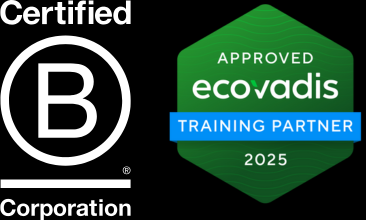The aim of this guide is to help small and medium-sized companies (SMEs) improve their corporate sustainability and responsibility in the environmental, social and governance (ESG) fields in practice. With the development of the ESG market, legislative updates and changes in the expectations of customers, partners and investors, the field of sustainability plays an increasingly important role in building a strong and competitive business.
In part 6, we learned about setting your ESG goals and indicators. Now, in part 7, Strategy implementation and communication, we focus on putting your ESG strategy into action. This involves communicating your ESG plans to your team, assigning roles and responsibilities, and ensuring every part of your business is aligned with your ESG objectives.
Strategy implementation and communication
Implementation of ESG
Once you have defined your company’s key stakeholders and material topics, determined your ESG goals and defined measurable indicators for each goal, you need to put together an implementation plan to continuously monitor and evaluate your ESG activities and achieve your goals along the defined timeline. This will include the following steps:
- Communication of ESG strategy to employees by senior management
Explain what ESG means in the context of your business, how an ESG strategy will help you limit or eliminate negative impacts and expand positive benefits, and what it means for their roles. Employee support is essential to the success of your strategy.
Look for sustainability ambassadors among your employees and give them an opportunity to participate in the planning process. This will make them more invested in future outcomes and outputs. Celebrate every successful ESG initiative to foster employee motivation, enthusiasm and pride in your company.
- Public communication of ESG approach
Communicating your ESG strategy to the public is crucial – whether through reports, articles, product packaging or other printed materials. A comprehensive communications strategy to share your ESG efforts, goals and a plan to achieve those goals will show your stakeholders that you are taking action. It will also help hold you accountable for your goals. You can find more in the Communicating Your ESG Activities section.
- Delegation of ESG goals/activities to respective managers or department heads
Effective implementation of sustainable ESG activities means that this concept will be included in the day-to-day activities of the business. Ideally, you would have a designated ESG Manager dedicated to delegating and monitoring ESG activities within the company. However, a small company might not be able to hire an ESG specialist, so delegation of ESG responsibilities may come directly from senior management.
Delegation should involve matching the skills of your employees with the ESG topic as well as possible. For example, your HR person would take charge of employee-related initiatives, and your operational team would look at energy and resource efficiency. The “owner” of each ESG topic should then set the action plan, i.e., defining the necessary projects, team members and budget for their focus area. Owners of different sustainability initiatives should coordinate their activities and meet regularly as a “Sustainability Committee”. This committee should ensure that the ESG strategy is being implemented in a unified and coordinated fashion.
- Regular review of ESG progress towards goals by senior management
The progress of ESG activities towards the set goals should be regularly communicated to senior management. If such activities stagnate, reviewing the strategy and making the necessary changes is necessary.
Communicating your ESG activities
Communicating your ESG activities is as important as the money and time you invest in them. When people understand your vision for a responsible business, your values and the products/services that help you deliver on your vision, you are more attractive to them as a company. Plus, you are one step ahead of your competitors and set an example of good practice for other companies.
Thoughtful, regular and relevant communication brings many benefits to companies:
- New business opportunities
- Greater customer satisfaction and loyalty
- Improved company, brand and product reputation
- More motivated and productive employees
- Better relationships with the local community and public authorities
- Increased cost savings
Next, in part 8, we'll look at how to prepare an ESG report. This section will guide you on how to effectively compile and present your ESG activities and achievements in a comprehensive report.

